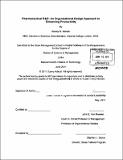| dc.contributor.advisor | John E. Van Maanen. | en_US |
| dc.contributor.author | Adeusi, Sunny O. (Sunday Oluwasogo) | en_US |
| dc.contributor.other | Sloan School of Management. | en_US |
| dc.date.accessioned | 2011-09-13T17:53:33Z | |
| dc.date.available | 2011-09-13T17:53:33Z | |
| dc.date.copyright | 2011 | en_US |
| dc.date.issued | 2011 | en_US |
| dc.identifier.uri | http://hdl.handle.net/1721.1/65794 | |
| dc.description | Thesis (S.M.)--Massachusetts Institute of Technology, Sloan School of Management, 2011. | en_US |
| dc.description | Cataloged from PDF version of thesis. | en_US |
| dc.description | Includes bibliographical references (p. 102-112). | en_US |
| dc.description.abstract | The pharmaceutical industry is an $837 billion a year industry that is being plagued by low R&D productivity. This decline in productivity has resulted in significant erosion of value. From December 2000 to February 2008, the top 15 pharmaceutical companies lost about $850 billion in shareholder value and their stock price fell precipitously from 32 times earnings to an average of 13 (Garnier, 2008). In an attempt to boost R&D productivity, pharmaceutical companies are jettisoning their old lumbering and bureaucratic R&D organizations for de-centralized and entrepreneurial models in a wave of organizational redesigns that is aimed at delivering innovation and creating value. In this research, I have studied this new trend in organizational redesign by finding out what went wrong with the old model, what are the drivers for change, what is the new model and what strategic imperatives are they aimed at achieving. I have undertaken this by studying the top 5 research-based pharmaceutical companies. I have used interviews and extensive secondary research to gather facts and gain insight into issues and questions mentioned above. I then used the Three Organizational Lenses Framework by (Ancona et al, 2005) to analyze the new model at play in each of the 5 companies studied and proposed recommendations going forward. I found that whilst organizational design provides strong tools, techniques and systems for enhancing R&D productivity, implementing a new organizational structure alone will not suffice. There has to be a comprehensive approach that involves structure, systems and incentives; as well as paradigm shifts in both leadership and culture. | en_US |
| dc.description.statementofresponsibility | by Sunny O. Adeusi. | en_US |
| dc.format.extent | 112 p. | en_US |
| dc.language.iso | eng | en_US |
| dc.publisher | Massachusetts Institute of Technology | en_US |
| dc.rights | M.I.T. theses are protected by
copyright. They may be viewed from this source for any purpose, but
reproduction or distribution in any format is prohibited without written
permission. See provided URL for inquiries about permission. | en_US |
| dc.rights.uri | http://dspace.mit.edu/handle/1721.1/7582 | en_US |
| dc.subject | Sloan School of Management. | en_US |
| dc.title | Pharmaceutical R&D : an organizational design approach to enhancing productivity | en_US |
| dc.title.alternative | Pharmaceutical research and development | en_US |
| dc.type | Thesis | en_US |
| dc.description.degree | S.M. | en_US |
| dc.contributor.department | Sloan School of Management | |
| dc.identifier.oclc | 750001856 | en_US |
